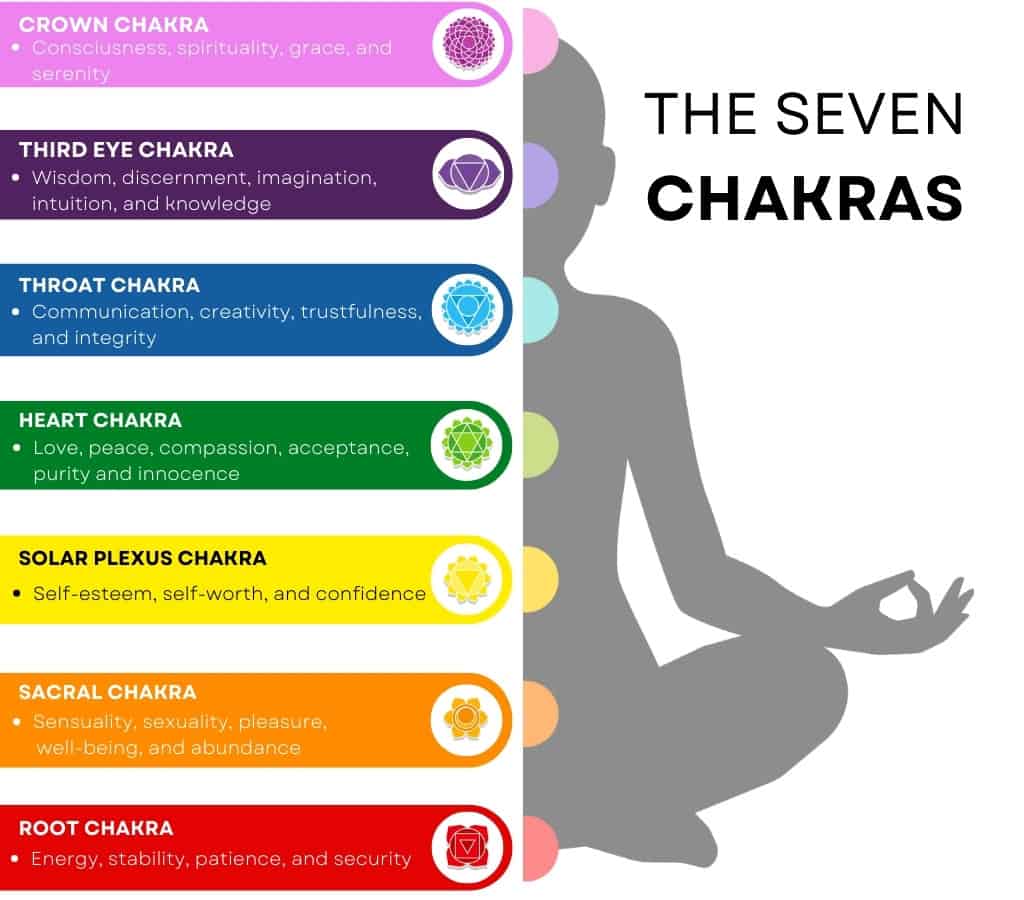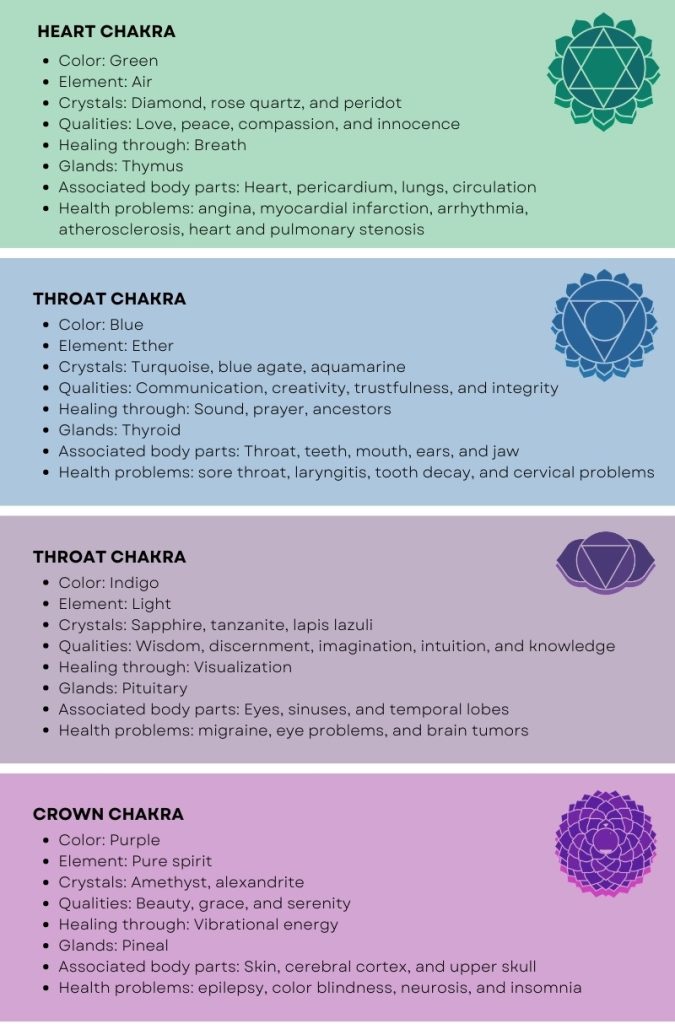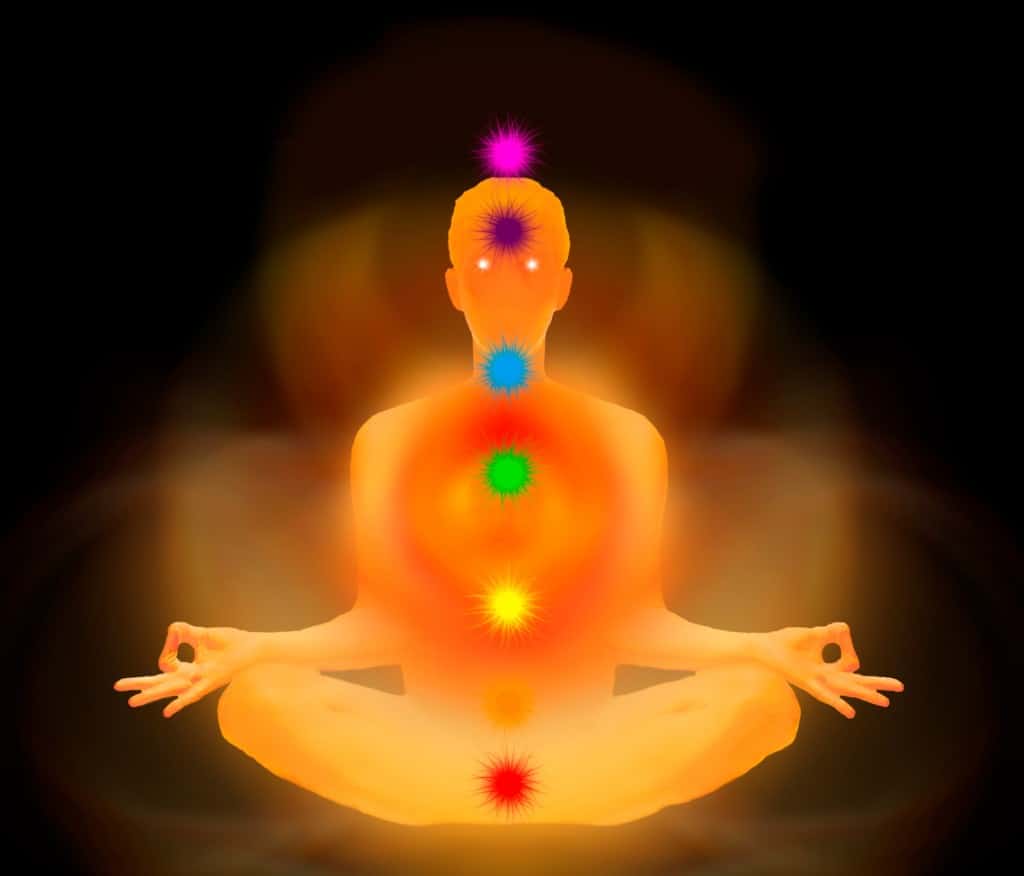In today’s article, we will discuss the seven chakra colors and their meanings, as well as how they affect our psychological well-being, physical health, and spiritual awakening.
Chakra Colors and Meanings
We’ve all heard of chakras and the colors associated with them, as well as their associated meanings of spiritual awakening, well-being, and physical health.
Because each chakra is assigned a color, there is a close relationship between its characteristics and the meaning of the color.
It is interesting to mention that the colors of the chakras resonate with the colors of the rainbow.
More specifically, each chakra resonates with a different color of the rainbow, beginning with red for the root chakra and ending with purple for the Crown chakra.
This article will go over the meaning of chakra colors, where they are located, what they represent, and their attributes and qualities.

What Are Chakras?
Chakras are your very soul, the wheels of vibrating light that bestow wisdom and enlightenment. They make you aware of the amount of spiritual, psychological, and physical strength that you possess.
The Sanskrit word “chakra,” which translates to “wheel,” alludes to the wheels of divine light. Seven primary chakras radiate out from various points along the spine, forming a vertical axis from the base of the spine to the top of the head.
It refers to the energy that surrounds and within all living things. It is a model that explains the finer energy levels. So, our energy system comprises seven energy levels within the aura that influence our physical, emotional and mental states.
Each chakra corresponds to various attributes and is associated with a specific color. They also have different levels of awareness and energetic charge.
The lower chakras are magnetic in nature, whereas the upper chakras are electrical.
The chakras have an impact on all facets of our lives.
A grounded lifestyle and loving thoughts toward oneself and others maintain their health and integrity.
How Many Chakras Are There?
There are seven major chakras located along the spine. It is believed that they provide subtle energy that allows the mind, intellect, and organs to function optimally.
The bottom three chakras, positioned below the diaphragm, can personally impact us, particularly your relationship with your body, and their role is most receptive.
The upper four chakras are concerned with releasing energy through communication, living, inner contemplation, and positive attitudes. They are referred to as universal chakras due to their deeper spiritual impacts.
The patterns for disease, health, fortitude, and stealth essential to be alive are carried through the lower chakras, connecting us to Mother Earth.
The top chakras become active as we become spiritual and capable of love and as they connect us to the source.
In the event that one chakra fails, the others will attempt to compensate.
The Function of The Chakras
The nature of chakras is non-anatomical. They can be found in the Etheric body, the layer of energy closest to the Physical body.
The chakras permeate all seven layers of the aura. They perform the role of conductors, pulling life force energy from the earth, moving it throughout the physical body, and releasing it as higher awareness.
The chakras are the repositories of our life-related thoughts, emotions, and attitudes.
When something blocks the flow of life energy, the chakras slow down, and energy may become stagnant. In this situation, they must be stimulated to become active again.
Thus, having open chakras is essential for our health and well-being.
What Are The 7 Chakra Colors?
The chakras, known as the energetic core of human existence, resonate with rainbow colors. As a result, the chakra colors and meanings are linked to the meanings of the colors.
- Root Chakra, or Muladhara: Color Red
- Sacral Chakra, or Svadisthana: Color Orange
- Solar Plexus Chakra, or Manipura: Color Yellow
- Heart Chakra, or Anahata: Color Green
- Throat Chakra, or Vishuddi: Color Blue
- Third Eye Chakra, or Ajna: Color Indigo
- Crown Chakra, or Sahasrara: Color Purple, Violet
Root chakra – Muladhara

- Location: at the base of the spine in the perineum
- Color: Red color
- Mantra: Lam
- Element: Earth
- Glands: Adrenal cortex
- Associated body parts: kidneys and the skeletal system
Meaning: The root chakra assists us in managing our life force and is associated with qualities of security, stability, and order. The spiritual significance of the root chakra is related to grounding.
One of the root chakra’s most positive attitudes is a spiritual belief in the goodness of life.
The qualities and attributes of the red chakra are patience, stability, and security.
Each chakra is responsive to our thoughts and feelings. The Root Chakra is impacted by aggression, which can easily transform into rage and violence if not expressed. As a result, negative attitudes associated with this chakra can cause feelings of violence and hatred.
Any blockage or dysfunction of the root chakra, also known as the red chakra, may result in foot, knee, and hip problems. Arthritis, osteoporosis, kidney stones, and bone issues are among them. Autoimmune deficiency illnesses are another type of physical ailment that can manifest as a root chakra issue.
Sacral chakra – Svadisthana

- Location: two inches below the navel
- Color: Orange color
- Mantra: Vam
- Element: Water
- Glands: Gonads
- Associated body parts: Reproductive organs
Meaning: The sacral chakra governs attitudes toward health, pleasure, and deservingness. The orange chakra is the gateway to the realms of health, pleasure, well-being, and prosperity.
The orange chakra also represents the emotional state and the sense of creativity.
Sensuality, pleasure, well-being, and abundance are the qualities and attributes of the orange chakra.
The sacral chakra is associated with knowledge, trust, and self-love. It also has a spiritual-centering quality.
As the seat of pleasure and well-being, the sacral chakra has a less aggressive emotional response.
Respecting our bodies’ needs for rest, recreation, and expression aids in the transformation of negative attitudes into positive ones.
In women, dysfunction of the sacral chakra can result in endometriosis, sterility, fibroids, ovarian difficulties, and prolonged monthly cramping. In men, the blockage of the Sacral Chakra can result in prostate issues, sexual dysfunction, and infertility.
Solar Plexus chakra – Manipura

Location: over the stomach and below the sternum
- Color: Yellow color
- Mantra: Ram
- Element: Fire
- Glands: pancreas
- Associated body parts: stomach, liver, pancreas, gallbladder, small intestine
Meaning: The solar plexus chakra is associated with power, confidence, motivation, and freedom of choice. The yellow chakra, the center of physical needs, conveys feelings of warmth as its color of sunshine does.
The yellow chakra is in charge of self-worth, self-esteem, and personal power. It’s the place where a lot of energy is processed.
The Solar Plexus Chakra’s emotions revolve around power, reflecting our relationship to inner strength and self-worth.
Honoring oneself attracts an abundance of kindness, goodness, and respect.
The yellow chakra qualities and attributes include self-esteem, self-worth, and confidence.
An unbalanced Solar Plexus chakra can lead to digestive disorders such as indigestion, ulcers, gastroesophageal reflux disease, hepatitis, pancreatitis, and diabetes.
Heart chakra – Anahata

- Location: in the middle of the chest
- Color: Green color
- Mantra: Yam
- Element: Air
- Glands: Thymus
- Associated body parts: heart, pericardium, lungs
Meaning: The heart chakra expresses thoughts and feelings about our worthiness in giving and receiving love. It evokes feelings of love, empathy, and forgiveness. Its attitudes are based on love, compassion, and healing. The chakra is also known as the green chakra.
Moreover, the Heart Chakra is the center of love and allows us to love ourselves and others. It allows us to experience peace, compassion, and joy.
Allowing love to be at the center of our lives keeps our spirits open and our hearts beating.
The green chakra qualities and attributes include love, peace, compassion, purity, and innocence.
A blockage of the Heart Chakra can result in heart problems such as angina, myocardial infarction, arteriosclerosis, and heart stenosis. In addition, heart chakra dysfunction can lead to lung diseases such as pneumonia, chronic bronchitis, and tuberculosis.
Throat chakra – Vishuddha

- Location: at the level of the throat
- Color: Blue color
- Mantra: Ham
- Element: Ether
- Glands: Thyroid
- Associated body parts: throat, mouth, teeth, ears, and jaw
Meaning: The throat chakra is controlled by the mind, allowing us to express ourselves eloquently and gracefully.
The Throat Chakra, also known as the Blue Chakra or “the mouth of God,” is the channel for communication and creativity, and it is essential for our personal growth.
As a result, the blue chakra assists us in expressing ourselves and releasing feelings.
The throat chakra serves as our communication hub, connecting us to angelic forces and ancestral realms. When balanced, this chakra can provide clarity in determining our life’s path. It also serves as a spiritual guide.
Indigo is a color associated with self-awareness and self-reflection. Indigo represents clarity and intuition by borrowing characteristics from both red (energy) and blue (peace).
The blue chakra qualities and attributes also include communication, creativity, trustworthiness, and integrity.
Blue has meanings associated with peace and calm. As a result, the color’s properties help to calm the mind and decelerate the intensity of thoughts.
Honoring the truth and communicating is what keeps us on track.
A dysfunctional Throat chakra can result in sore throat, laryngitis, cavities, and cervical issues. It could also be related to the temporomandibular joint syndrome.
Third Eye chakra – Ajna

- Location: between the eyebrows
- Color: Indigo color
- Mantra: Om
- Element: Light
- Glands: Pituitary
- Associated body parts: eyes, sinuses, temporal lobes
Meaning: Also known as the mind’s control center, the third eye chakra, is where our mentality is formed.
The Third Eye chakra, or the indigo chakra, allows us to explore the realms of knowledge and develop inner knowing.
This chakra focuses on developing a strong and independent mind. As a result, our intelligence has the ability to create harmony or conflict.
The third eye chakra governs inner vision, insight, and wisdom. Inner contemplation and spiritual reflection are two of the best gifts of the third eye chakra.
Our emotional responses are regulated by the Third Eye Chakra. Therefore, we must allow ourselves to feel and experience emotions in order for them to vanish.
The indigo chakra is associated with wisdom, discernment, creativity, intuition, and knowledge.
Accepting the best in ourselves aids in defining boundaries in the face of any outside offense.
This chakra may become blocked as a result of emotional suppression. As a result, the indigo chakra allows us to feel our feelings and reflect on them.
Brow Chakra dysfunction can result in issues with intelligence, dual affectivity, and overwork, which can lead to migraines and eye problems.
Crown chakra – Sahasrara

- Location: top of the skull
- Color: Purple color, or violet
- Mantra: None
- Element: Pure spirit
- Glands: Pineal
- Associated body parts: skin, cerebral cortex, and upper skull
Meaning: The crown chakra, which has a spiritual dimension, opens the realm of high thinking for us. It has the joyful sense of the divine and only one emotion, which is bliss.
Purple/violet and white are the colors associated with the Crown Chakra.
Beauty, grace, and serenity are some of the characteristics and qualities of the purple chakra.
Accepting gratitude and realizing that God loves and protects us is what causes our consciousness to be free of anxiety.
A malfunctioning Crown chakra causes issues with learning, perception, and spiritual awareness. Additionally, the list of physical health problems includes sleeplessness, epilepsy, color blindness, and nerve diseases.
Chakra Colors Chart


To embed this infographic on your website, copy and paste the code below. Otherwise, no usage rights will be granted.
<img src="https://thecolorsmeaning.com/wp-content/uploads/2022/11/4-1.jpg"><img src="https://thecolorsmeaning.com/wp-content/uploads/2022/11/5-1.jpg"><small>Source: <a href="https://thecolorsmeaning.com/" rel="noopener" target="_blank">TheColorsMeaning.com</a> - See more about the <a href="https://thecolorsmeaning.com/chakra-colors-and-meanings/" rel="noopener" target="_blank">chakra colors and meanings</a></small>Final Thoughts on the Chakra Colors and Meanings
In conclusion, the attributes and qualities of each chakra are associated with their respective color meanings.
You can understand how the layers of energy respond to healing through various methods, including color therapy, once you understand the meanings of the seven chakra colors.
The colors used in color therapy are those of the rainbow, and they influence how we feel and think. Colors influence our emotions and moods by resonating at different energy levels, so understanding them is essential.
We can revitalize our energies and vibrations by using colors wisely, balancing the chakras.

